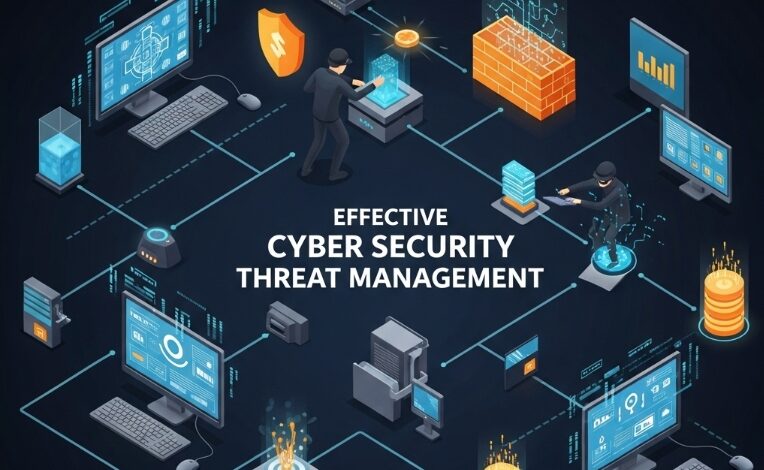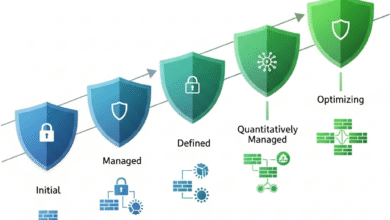Cyber Security Threat Management
Beyond Firewalls: Your Friendly Guide to Mastering Cyber Security Threat Management

Cyber Security Threat Management
Beyond Firewalls: Your Friendly Guide to Mastering Cyber Security Threat Management
Let’s face it, navigating the digital world these days can sometimes feel like walking through a minefield. Between sophisticated hackers, relentless malware, and ever-evolving scams, protecting your business or personal data is no longer optional – it’s essential. That’s where effective cyber security threat management becomes your absolute best friend. Think of it not just as a shield, but as your entire security operations center, constantly vigilant and ready to act. This guide breaks down what it really means, why it matters more than ever for American businesses and individuals, and how you can implement a robust strategy without drowning in tech jargon.
Why Cyber Security Threat Management Isn’t Optional (Especially in the USA)
The threat landscape in America is particularly intense. We’re a prime target for nation-state actors, financially motivated cybercriminals, and hacktivists alike. Consider these sobering stats:
-
Ransomware Reigns: Attacks hit a record high in 2023, with businesses facing average ransom demands soaring into the millions and crippling downtime.
-
Supply Chain Under Siege: Attacks like SolarWinds showed how compromising one vendor can ripple out to thousands of organizations, a tactic increasingly favored by advanced adversaries.
-
The Human Factor Persists: Phishing remains the #1 initial attack vector. Despite training, a single click on a cleverly disguised email can open the floodgates.
-
Cloud Complexity: As more businesses migrate to the cloud, misconfigurations and inadequate access controls create new, widespread vulnerabilities.
Simply having an antivirus and a firewall is like locking your front door but leaving all the windows wide open. Comprehensive cyber security threat management is the process of systematically identifying, assessing, prioritizing, and mitigating all potential threats across your entire digital ecosystem.
Unpacking the Cyber Security Threat Management Lifecycle
Effective cyber security threat management isn’t a one-time project; it’s an ongoing cycle of vigilance and improvement. Let’s break down the key phases:
-
Visibility & Discovery: Knowing What You’re Protecting (and Where the Weak Spots Are)
-
Asset Inventory: You can’t protect what you don’t know exists. This means cataloging all hardware, software, data, cloud instances, and network devices. It’s the foundational map for your cyber security threat management strategy.
-
Threat Intelligence: This isn’t just news headlines. It’s proactively gathering, analyzing, and applying information about emerging threats, attacker tactics (TTPs), vulnerabilities, and indicators of compromise (IoCs). Quality threat intelligence feeds your cyber security threat management systems with the latest “most wanted” list.
-
Continuous Monitoring: Employing tools like SIEM (Security Information and Event Management), EDR (Endpoint Detection and Response), XDR (Extended Detection and Response), and network traffic analysis tools to watch over your environment 24/7. This is the nervous system of your cyber security threat management operation.
-
-
Assessment & Prioritization: Separating the Signal from the Noise
-
Vulnerability Management: Regularly scanning systems and applications for known weaknesses (like unpatched software or configuration errors). But finding vulnerabilities is just the start. Effective cyber security threat management requires understanding which ones are actually exploitable in your specific environment and pose the highest risk.
-
Risk Analysis: Not all threats are created equal. This phase involves evaluating the likelihood of a specific threat exploiting a vulnerability and the potential impact (financial loss, reputational damage, operational disruption, regulatory fines). This allows you to focus your cyber security threat management resources where they matter most.
-
Threat Hunting: Proactively searching your network for hidden threats that evade automated detection. Skilled analysts use hypotheses based on threat intelligence and anomaly detection to uncover sophisticated attackers lurking within. This proactive stance elevates your cyber security threat management beyond just reactive measures.
-
-
Response & Mitigation: Taking Decisive Action
-
Incident Response (IR): Having a clear, tested plan is non-negotiable. When a threat is detected, your IR plan guides the team through containment (stopping the spread), eradication (removing the threat), recovery (restoring systems/data), and post-incident analysis (learning lessons). A swift, coordinated IR capability is the muscle of your cyber security threat management framework.
-
Patch Management: Systematically and promptly applying security updates to software, operating systems, and firmware is one of the single most effective cyber security threat management controls. Automate where possible!
-
Security Control Tuning & Implementation: This includes configuring firewalls, intrusion prevention systems (IPS), email security gateways, access controls, and encryption based on the identified threats and risks. Your cyber security threat management strategy dictates how these controls are deployed and optimized.
-
-
Review & Evolution: Learning and Getting Stronger
-
Post-Incident Analysis: After any security event (even a blocked attempt), conduct a thorough review. What happened? How was it detected? How effective was the response? What needs improvement? This feeds directly back into strengthening your cyber security threat management lifecycle.
-
Program Assessment: Regularly evaluate the overall effectiveness of your cyber security threat management program. Are you meeting your goals? Are new threats outpacing your defenses? Are your tools still fit for purpose? Use frameworks like NIST CSF or MITRE ATT&CK for benchmarking.
-
Continuous Improvement: Threat management is never “done.” Budget for ongoing training, tool updates, process refinement, and strategy adjustments based on lessons learned and the evolving landscape.
-
Essential Tools in the Cyber Security Threat Management Arsenal
No single tool does it all. A layered approach is key. Here are crucial components:
-
SIEM (Security Information and Event Management): The central log aggregator and correlation engine. Crucial for visibility and initial alerting within a cyber security threat management stack.
-
EDR/XDR (Endpoint/Extended Detection and Response): Goes beyond traditional antivirus, providing deep visibility into endpoint activity, detection of sophisticated attacks, and capabilities for investigation and response. Vital for modern cyber security threat management.
-
Vulnerability Scanners: Identify weaknesses in systems, applications, and network configurations – the raw data for your cyber security threat management risk assessments.
-
Threat Intelligence Platforms (TIPs): Help collect, aggregate, analyze, and operationalize threat intelligence feeds, enriching your cyber security threat management tools and processes.
-
SOAR (Security Orchestration, Automation, and Response): Helps automate repetitive tasks (like initial alert triage, blocking malicious IPs), orchestrate complex workflows across different tools, and standardize response playbooks. This significantly boosts the efficiency and speed of your cyber security threat management team.
-
Firewalls (Next-Generation – NGFW) & IPS: Network perimeter and internal segmentation guardians, enforcing access policies and blocking known malicious traffic – fundamental layers in cyber security threat management.
-
Email & Web Security Gateways: Filter out phishing, malware, and malicious websites at the point of entry – a critical first line of defense.
The Human Element: Your Most Crucial (and Vulnerable) Layer
Technology is powerful, but people are central to effective cyber security threat management:
-
Skilled Security Analysts: The heroes in the SOC (Security Operations Center). They investigate alerts, hunt threats, and manage incidents. Talent shortage is real, making training and retention key.
-
Security Awareness Training: Empowering every employee to recognize phishing, practice good password hygiene, and report suspicious activity transforms your workforce from a vulnerability into a vital part of your cyber security threat management human sensor network.
-
Executive Buy-In: Robust cyber security threat management requires investment and prioritization from the top. Leadership must understand cyber risk as a core business risk.
The Future of Cyber Security Threat Management: What’s Next?
The landscape keeps shifting. Key trends shaping the future:
-
AI & Machine Learning (ML): Supercharging threat detection (finding subtle anomalies), automating analysis, predicting attacks, and accelerating response times within cyber security threat management platforms. (But attackers use AI too!).
-
Zero Trust Architecture: Moving away from “trust but verify” inside the network to “never trust, always verify” for every user, device, and access request. This paradigm shift is increasingly fundamental to modern cyber security threat management strategies.
-
Consolidation (XDR & Platforms): Vendors are merging capabilities (EDR, NDR, SIEM, SOAR) into unified XDR platforms, aiming to simplify and improve efficacy for cyber security threat management teams struggling with tool sprawl.
-
Focus on Identity Security: With perimeter defenses less effective, securing identities (users, service accounts) with Multi-Factor Authentication (MFA), Privileged Access Management (PAM), and identity threat detection becomes paramount in cyber security threat management.
-
Rise of Cyber Insurance: While not a prevention tool, it’s becoming a critical risk transfer mechanism. Insurers now demand robust cyber security threat management practices as a prerequisite for coverage.
Taking Action: Building Your Cyber Security Threat Management Resilience
Feeling overwhelmed? Start here:
-
Assess Your Current State: Honestly evaluate where you stand. What assets do you have? What protections are in place? When was your last risk assessment? Understanding your baseline is step one in improving cyber security threat management.
-
Define Your Strategy: Align your cyber security threat management goals with your business objectives. What are you protecting, and why? What risks are unacceptable?
-
Prioritize Investments: Focus on foundational elements first: robust backups, timely patching, MFA everywhere, employee training, and basic incident response planning. You don’t need the most expensive tools day one for effective cyber security threat management.
-
Leverage Frameworks: Use established frameworks like the NIST Cybersecurity Framework (CSF) or CIS Critical Security Controls as a roadmap for building your cyber security threat management program.
-
Consider Expertise: If internal resources are limited, explore Managed Security Service Providers (MSSPs) or Managed Detection and Response (MDR) services. They can provide 24/7 cyber security threat management capabilities and expertise.
-
Test & Refine: Regularly test your incident response plan (tabletop exercises!), run phishing simulations, and reassess your vulnerabilities. Cyber security threat management thrives on continuous improvement.
The Bottom Line: Empowerment Through Vigilance
Cyber security threat management isn’t about achieving perfect, impenetrable security (that’s impossible). It’s about building resilience. It’s about understanding your risks, having the visibility to see threats coming (as much as possible), the capability to respond effectively when they hit, and the processes to learn and adapt. For American businesses and individuals navigating today’s complex digital dangers, a strategic, well-executed cyber security threat management program isn’t just a technical necessity; it’s a fundamental pillar of operational continuity, trust, and peace of mind. Start building your resilience today – your digital future depends on it.




